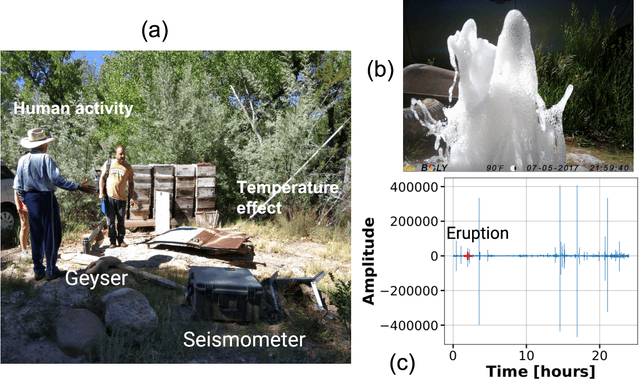G. D. Guthrie
Using Machine Learning to Discern Eruption in Noisy Environments: A Case Study using CO2-driven Cold-Water Geyser in Chimayo, New Mexico
Oct 01, 2018



Abstract:We present an approach based on machine learning (ML) to distinguish eruption and precursory signals of Chimay\'{o} geyser (New Mexico, USA) under noisy environments. This geyser can be considered as a natural analog of $\mathrm{CO}_2$ intrusion into shallow water aquifers. By studying this geyser, we can understand upwelling of $\mathrm{CO}_2$-rich fluids from depth, which has relevance to leak monitoring in a $\mathrm{CO}_2$ sequestration project. ML methods such as Random Forests (RF) are known to be robust multi-class classifiers and perform well under unfavorable noisy conditions. However, the extent of the RF method's accuracy is poorly understood for this $\mathrm{CO}_2$-driven geysering application. The current study aims to quantify the performance of RF-classifiers to discern the geyser state. Towards this goal, we first present the data collected from the seismometer that is installed near the Chimay\'{o} geyser. The seismic signals collected at this site contain different types of noises such as daily temperature variations, seasonal trends, animal movement near the geyser, and human activity. First, we filter the signals from these noises by combining the Butterworth-Highpass filter and an Autoregressive method in a multi-level fashion. We show that by combining these filtering techniques, in a hierarchical fashion, leads to reduction in the noise in the seismic data without removing the precursors and eruption event signals. We then use RF on the filtered data to classify the state of geyser into three classes -- remnant noise, precursor, and eruption states. We show that the classification accuracy using RF on the filtered data is greater than 90\%.These aspects make the proposed ML framework attractive for event discrimination and signal enhancement under noisy conditions, with strong potential for application to monitoring leaks in $\mathrm{CO}_2$ sequestration.
Regression-based reduced-order models to predict transient thermal output for enhanced geothermal systems
Jul 12, 2017



Abstract:The goal of this paper is to assess the utility of Reduced-Order Models (ROMs) developed from 3D physics-based models for predicting transient thermal power output for an enhanced geothermal reservoir while explicitly accounting for uncertainties in the subsurface system and site-specific details. Numerical simulations are performed based on Latin Hypercube Sampling (LHS) of model inputs drawn from uniform probability distributions. Key sensitive parameters are identified from these simulations, which are fracture zone permeability, well/skin factor, bottom hole pressure, and injection flow rate. The inputs for ROMs are based on these key sensitive parameters. The ROMs are then used to evaluate the influence of subsurface attributes on thermal power production curves. The resulting ROMs are compared with field-data and the detailed physics-based numerical simulations. We propose three different ROMs with different levels of model parsimony, each describing key and essential features of the power production curves. ROM-1 is able to accurately reproduce the power output of numerical simulations for low values of permeabilities and certain features of the field-scale data, and is relatively parsimonious. ROM-2 is a more complex model than ROM-1 but it accurately describes the field-data. At higher permeabilities, ROM-2 reproduces numerical results better than ROM-1, however, there is a considerable deviation at low fracture zone permeabilities. ROM-3 is developed by taking the best aspects of ROM-1 and ROM-2 and provides a middle ground for model parsimony. It is able to describe various features of numerical simulations and field-data. From the proposed workflow, we demonstrate that the proposed simple ROMs are able to capture various complex features of the power production curves of Fenton Hill HDR system. For typical EGS applications, ROM-2 and ROM-3 outperform ROM-1.
* 25 pages, 8 figures
 Add to Chrome
Add to Chrome Add to Firefox
Add to Firefox Add to Edge
Add to Edge